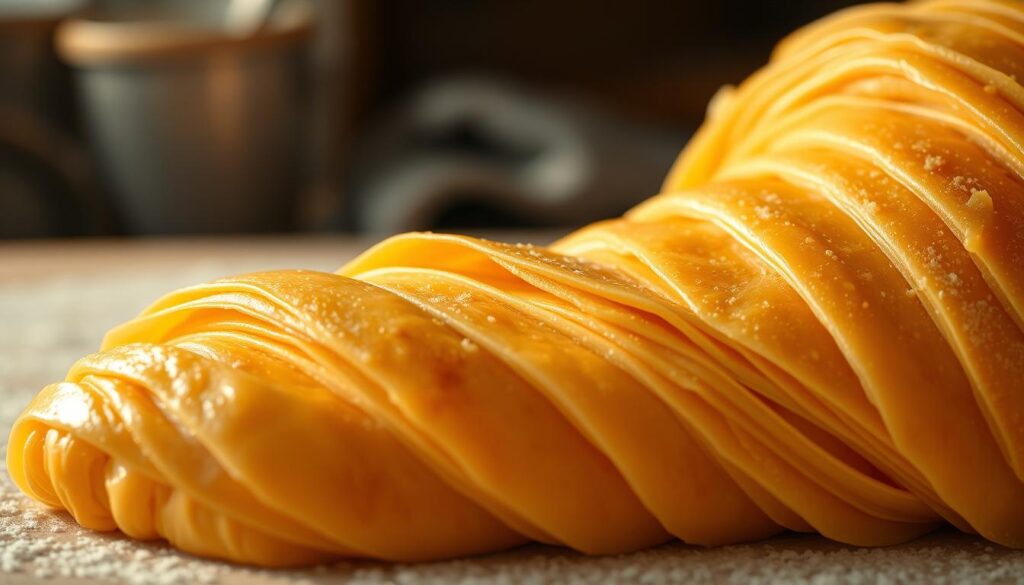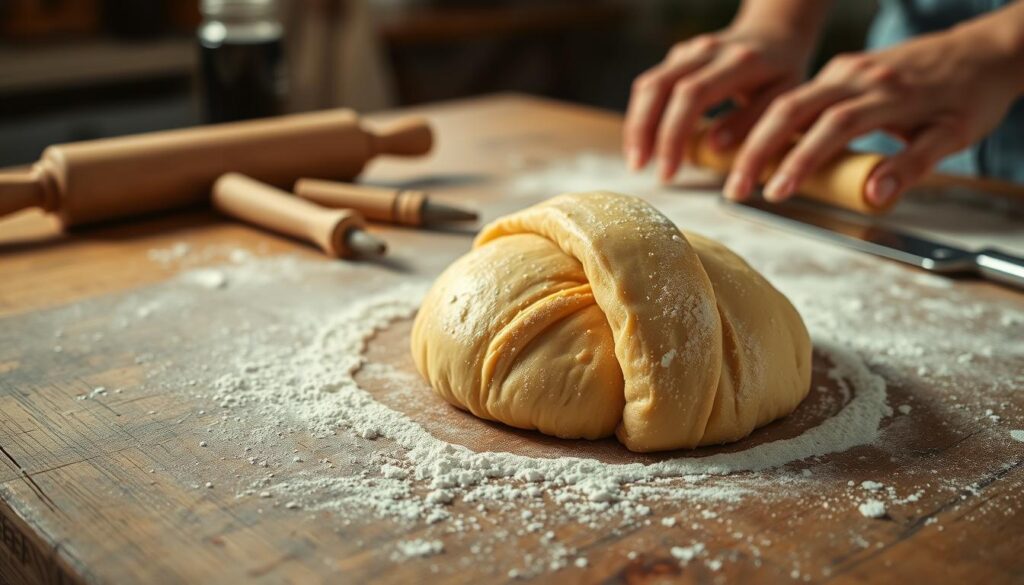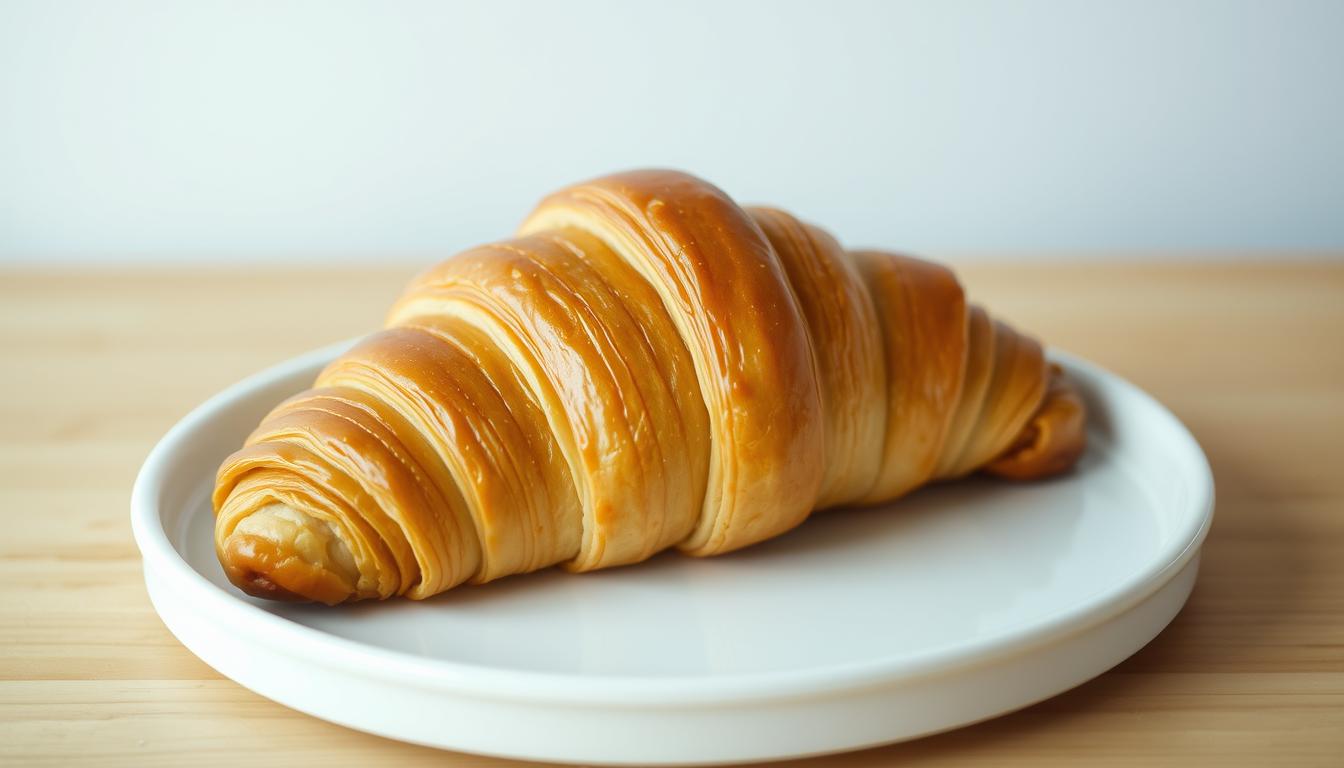Ever dreamed of making croissants like a bakery in your kitchen? The smell of freshly baked croissants can make any morning feel special. Imagine pulling out golden, flaky pastries from the oven. They’re so delicate, they almost melt in your mouth.
Making homemade flaky croissants is more than a recipe. It’s a way to connect with French baking traditions. Our easy method will help you make those delicious, buttery pastries that seem hard to make at home.
Whether you’re new to baking or have lots of experience, this guide will help you make perfect croissants. You’ll learn how to pick the right ingredients and master the lamination process. Soon, you’ll be making pastries that are as good as those from French bakeries.
Key Takeaways
- Create authentic French bakery-style croissants at home
- Master the art of laminated dough in just a few hours
- Understand the critical techniques for achieving perfect flaky layers
- Learn how to work with butter and dough like a professional baker
- Impress family and friends with your homemade butter croissant recipe
Understanding French Croissants: A Classic Pastry Heritage
Explore the world of French baking and learn about croissants. These flaky pastries are more than breakfast food. They are a culinary art with a deep history.
Origins of Croissants
The story of croissants starts centuries ago. The Austrian kipferl, a pastry from the 13th century, is their ancestor. In 1838, Austrian baker August Zang brought the kipferl to Paris at his Boulangerie Viennoise. This is when the French croissant was born.
- 13th century: Kipferl first appears in Austria
- 1838: Introduction to French cuisine
- Paris: Epicenter of croissant evolution
What Makes a Perfect Croissant
A perfect croissant is a work of art in viennoiserie. It has layers and a buttery taste. The secret is the lamination process. This involves folding cold butter into the dough to create layers that puff up when baked.
Types of Traditional Croissants
French bakeries offer many croissant types, each with its own charm:
- Butter Croissants: Classic straight shape, made with pure butter
- Curved Croissants: Often made with margarine or alternative fats
- Filled Croissants: Chocolate, almond, or other creative variations
About 60% of croissant fans love the traditional ones. The other 40% go for the filled ones. Making croissants is so important that 85% of pastry chefs see it as a key skill.
Essential Ingredients for Homemade Flaky Croissants
Making authentic croissants begins with picking top-notch ingredients. The quality of your ingredients will directly affect your baked goods. Choosing the best ingredients is key to making a truly delicious pastry.
Let’s look at the key ingredients that turn your kitchen into a pro bakery:
- Flour: Pick bread flour with 11-12% protein for the best structure
- Butter: Go for butter with at least 80% fat for flaky layers
- Yeast: Active dry yeast is best for rising
- Salt: Kosher salt adds great flavor
- Milk: Whole milk adds richness
- Sugar: Granulated sugar helps with fermentation
The success of your croissants depends on the quality and amount of each ingredient. Professional bakers know that each part is vital for texture and taste.
| Ingredient | Quantity | Purpose |
|---|---|---|
| All-Purpose Flour | 665 grams | Structural foundation |
| Unsalted Butter | 350 grams | Lamination and flavor |
| Fresh Yeast | 20 grams | Leavening agent |
| Sugar | 65 grams | Fermentation support |
| Salt | 13 grams | Flavor enhancement |
Knowing the role of each ingredient helps you make your baked goods truly professional.
Tools and Equipment You’ll Need
Making delicious homemade pastry is more than just skill. You need the right tools to make your breakfast baking better. Professional bakers know that good equipment is key to making flaky, tasty croissants.
Getting ready for croissant making means having the right tools. These tools help you work with precision and succeed.
Must-Have Baking Tools
- Rolling Pin: A sturdy, long rolling pin helps create uniform dough layers
- Pastry Scraper: Invaluable for handling delicate dough and making clean cuts
- Large baking sheets with rimmed edges
- Parchment paper or silicone baking mats
- Sharp knife or pastry wheel for precise cutting
Optional but Helpful Equipment
- Digital kitchen scale for precise ingredient measurement
- Bench scraper for dough handling
- Pastry brush for egg wash application
- Dough docker for preventing excessive rising
Temperature Control Essentials
| Tool | Purpose | Recommended Temperature Range |
|---|---|---|
| Digital Instant-Read Thermometer | Monitor ingredient and room temperatures | 68-76°F (ideal for croissant making) |
| Refrigerator Thermometer | Ensure proper dough resting temperature | 38-40°F |
Investing in these tools will improve your pastry-making skills. You’ll be able to make professional-quality croissants in your own kitchen.
Mastering the Art of Laminated Dough

French baking is all about making perfect laminated dough. It turns simple ingredients into amazing pastries. The secret is in the layers of dough and butter that make the pastry flaky and delicious.
Getting the dough right means paying close attention to temperature and technique. The butter block should be between 52 to 61°F. The dough around it should be cooler, between 36 to 43°F. This keeps the butter just right for making the layers.
- Butter makes up nearly half of the dough’s weight
- Butterfat content should be 82-86%
- Dough needs 10-15 minutes to rest
- Use a ruler for exact measurements
The secret to great laminated dough is folding and resting. Each fold adds more layers. Bakers do three to four “turns” or folds to get the layers right. This makes the dough flaky when it bakes.
“Lamination is not just a technique, it’s an art form in french baking.”
Professional bakers use a dough sheeter for even thickness. But home bakers can get the same results with careful rolling and precise measurements. Always dust off extra flour and handle the dough gently to keep the butter layers intact.
The Secret to Perfect Butter Layering
Mastering butter layering is key to making viennoiserie as good as French bakeries. Your croissant recipe’s success depends on how well you mix butter into the dough.
Professional bakers say butter is magic for flaky layers. European-style butter, with 82% fat, is the best for flavor and texture in croissants.
Butter Temperature Guidelines
Getting the right butter consistency is essential. You need butter that:
- Is softened but cool to the touch
- Can be rolled into a flat rectangle
- Stays firm during lamination
Folding Techniques for Flaky Layers
Lamination needs precision. Bakers suggest doing 3-4 folds to make your croissant dough flaky.
| Fold Type | Purpose | Recommended Technique |
|---|---|---|
| Single Turn | Initial butter integration | Fold dough over butter block at 45° angle |
| Double Turn | Increase layer complexity | Fold dough into thirds like a letter |
| Book Turn | Maximize flakiness | Fold dough in half, creating more layers |
Pro tip: Always refrigerate your dough between turns. This keeps butter from melting and makes your croissants crisp.
Step-by-Step Croissant Dough Preparation

Making the perfect homemade flaky croissant starts with careful dough preparation. French baking is all about precision and patience, especially with this delicate pastry. Let’s explore the key steps for making your croissant dough.
First, gather your ingredients with care. You’ll need:
- 18 oz all-purpose flour (just over 4 cups)
- ¼ cup + 1 Tbsp granulated sugar
- 2½ tsp fine sea salt
- 1 Tbsp + 1/2 tsp instant yeast
- ½ cup + 2 Tbsp cold water
- ½ cup + 2 Tbsp cold whole milk
- 3 Tbsp unsalted butter for dough
Mix the dry ingredients in a stand mixer. Knead the mixture until the dough comes together smoothly. This step is key for the right texture in your homemade flaky croissant.
Then, cover the dough with plastic wrap and rest for 10 minutes. This rest lets the gluten relax, improving your french baking. After resting, add the butter and knead for 10-15 minutes until the dough is soft and pliable.
Pro tip for your homemade pastry: Keep the dough temperature between 75-90°F during rising. Let it rise for 1½ to 2 hours, until it nearly doubles in size. This creates the ideal base for your authentic croissants.
The secret to great croissants lies in patience and precise technique.
Creating the perfect croissant is an art that needs practice and focus. Your homemade flaky croissant will be worth every minute of careful preparation.
Shaping and Rolling Techniques
Making artisan bread like croissants needs careful shaping and rolling. Your homemade treats will turn into professional-looking pastries with these techniques.
Start by rolling your dough into a 60×30 cm (24×12 inches) rectangle. This step is key for making croissants that look and taste great.
- Mark 5 cm (2-inch) intervals along the top and bottom edges
- Cut the dough into triangular shapes with clean, sharp edges
- Stretch each triangle’s tail and top slightly before rolling
When shaping, make a small slit at the top of each triangle. This helps create the classic crescent shape and ensures even rolling.
| Croissant Shaping Steps | Key Details |
|---|---|
| Dough Rectangle Size | 60×30 cm (24×12 inches) |
| Triangle Cutting Interval | 5 cm (2 inches) |
| Expected Yield | 12 croissants approximately |
Pro tip: Keep the dough thickness at 5 mm (1/4 inch) for the best layering and flakiness.
“The secret to perfect croissants lies in the delicate balance of technique and patience.” – Artisan Baker’s Wisdom
Practice these techniques to make your homemade baked goods look like they came from a pro. They’ll impress your family and friends.
Proofing and Baking Guidelines
Your breakfast baking journey ends with the proofing and baking steps. Place your croissants on a parchment-lined baking sheet, with tails down and space to grow. Cover them with plastic wrap to help them rise gently.
The right proofing environment is key for flaky layers. Keep the temperature between 75 to 78 degrees Fahrenheit. This is usually in a turned-off oven or a warm kitchen. Let them double in size for 1 to 2 hours, making them light and airy.
Before baking, brush the croissants with an egg wash for a golden look. Preheat your oven to 375°F for 15 minutes. Bake for 20 to 25 minutes until they’re golden and crisp. Let them cool on a wire rack for 10 minutes to set.
Your patience and careful baking will turn simple dough into a delicious breakfast treat. Look for a deep golden color and listen for the crisp, buttery layers as they cool.
FAQ
How difficult is it to make homemade croissants?
Making croissants is a bit of a challenge, but our guide makes it easier. It breaks down the steps clearly. With the right technique and temperature, you can make croissants just like the pros.
What makes croissants so uniquely flaky?
The secret to flaky croissants is the lamination process. By folding butter into the dough, you create thin layers. This makes the croissants light and airy, giving them their special texture.
Can I use regular butter for croissants?
For the best taste, use high-quality European-style butter. It has more fat, which makes the croissants extra buttery and delicate.
How long does it take to make croissants from scratch?
Making croissants takes about 12-24 hours. This includes resting and chilling times. Most of this time is spent waiting, not actively working.
Can I freeze croissant dough?
Yes, you can freeze the dough at different stages. After shaping, freeze the croissants. Then, bake them straight from the freezer, adding a bit more time.
What’s the difference between butter croissants and other types?
Traditional butter croissants use pure butter lamination. This makes them rich and flaky. Other types might have fillings like chocolate or ham, but the basic technique is the same.
How do I know when my croissants are properly proofed?
Proofed croissants are puffy and light. They should spring back when pressed gently. They should also grow by 50-75% in size.
What’s the best way to store homemade croissants?
Keep freshly baked croissants in a paper bag at room temperature for 1-2 days. For longer storage, freeze them in an airtight container for up to two weeks. Reheat in the oven to refresh.
Can I make croissants without a stand mixer?
Yes, you can make croissants by hand. Use a large bowl and some effort. The key is to knead the dough carefully and consistently.
Why do my croissants leak butter during baking?
Butter leakage happens when the dough is too warm or the butter isn’t mixed well. Keep the dough cold and use precise folding to prevent butter from leaking during baking.

